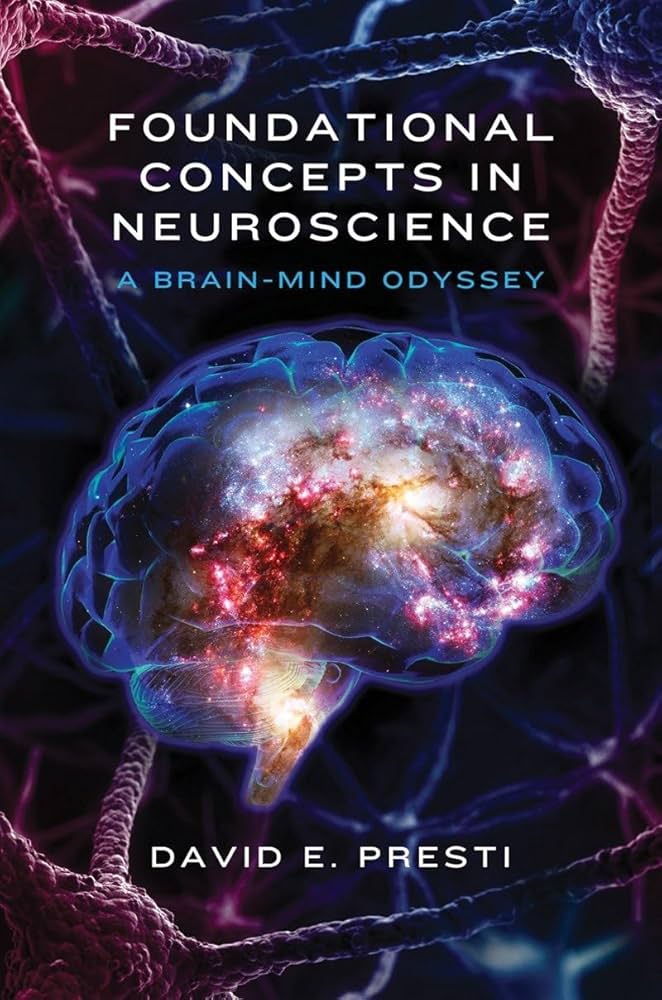What’s it about?
Foundational Concepts in Neuroscience (David E. Presti) is an accessible tour of how nervous systems work—from molecules and membranes to memory, emotion, and mind. It connects cellular mechanisms (ions, channels, neurotransmitters) to systems-level functions (perception, action, cognition), giving you the vocabulary and mental models to make sense of brains in health and disease.
Book Review: Foundational Concepts in Neuroscience

by David E. Presti
Published: (textbook reference)
Review published: September 2025
Important Concepts & Definitions (Quick-Reference)
- Neuron: The core information-processing cell of the nervous system; integrates inputs and sends outputs via electrical impulses (action potentials).
- Glia: Support cells. Astrocytes (metabolic support, neurotransmitter uptake), oligodendrocytes (CNS myelin), Schwann cells (PNS myelin), microglia (immune defense).
- Gray vs. White Matter: Gray = neuron cell bodies/synapses; White = myelinated axon tracts.
- CNS/PNS: Central nervous system (brain, spinal cord); peripheral nervous system (nerves and ganglia outside the CNS).
- Resting Membrane Potential (~–70 mV): Voltage difference across the neuronal membrane due to ion gradients (Na⁺, K⁺, Cl⁻) and selective permeability.
- Ion Channels & Pumps: Proteins that allow ions to cross membranes (e.g., voltage-gated Na⁺/K⁺ channels) and restore gradients (Na⁺/K⁺-ATPase pump).
- Action Potential: All-or-none electrical spike caused by rapid Na⁺ influx and K⁺ efflux; propagates along axons to signal downstream neurons.
- Myelin & Saltatory Conduction: Insulation that speeds conduction by letting impulses “jump” between nodes of Ranvier.
- Synapse: Junction where a presynaptic neuron releases neurotransmitter to influence a postsynaptic cell; can be chemical (via vesicles) or electrical (gap junctions).
- Neurotransmitter: Chemical messenger released at synapses; binds receptors to excite or inhibit postsynaptic targets.
- Glutamate (Glu): Primary excitatory neurotransmitter; key in plasticity and learning (e.g., NMDA/AMPA receptors).
- GABA: Primary inhibitory neurotransmitter in the brain; increases Cl⁻ conductance to hyperpolarize neurons.
- Acetylcholine (ACh): Attention, learning, REM sleep; neuromuscular junction contraction; receptors: nicotinic (ionotropic) & muscarinic (metabotropic).
- Dopamine (DA): Reward, motivation, movement; VTA–nucleus accumbens (reward), substantia nigra–striatal pathway (motor control). Dysregulation in addiction/Parkinson’s.
- Serotonin (5-HT): Mood, appetite, sleep, cognition; many receptor subtypes. Target of SSRIs in depression/anxiety.
- Norepinephrine (NE): Arousal, attention, stress responses; locus coeruleus projections broadly modulate cortex.
- Endocannabinoids: Retrograde lipid messengers (e.g., anandamide) that modulate synaptic release; target CB1 receptors.
- Opioid Peptides: Endogenous pain modulation and reward (endorphins, enkephalins); act at μ, κ, δ receptors.
- Agonist / Antagonist: Agonist activates a receptor; antagonist blocks it. Partial agonists produce submaximal activation.
- Tolerance & Dependence: Diminished drug effect with repeated use (tolerance); physiological adaptation leading to withdrawal on cessation (dependence).
- Synaptic Plasticity: Activity-dependent changes in synaptic strength—basis for learning/memory.
- LTP / LTD: Long-term potentiation (strengthening) and long-term depression (weakening) of synapses; often NMDA-dependent and Ca²⁺-mediated.
- Hebbian Learning: “Neurons that fire together wire together.” Co-activation strengthens connections.
- Short-Term / Working Memory (STM/WM): Temporary holding/manipulation of information over seconds to minutes; strongly linked to prefrontal cortex networks.
- Long-Term Memory (LTM): Durable storage (hours–years). Includes declarative (episodic, semantic) and nondeclarative (procedural/skills, priming, conditioning).
- Hippocampus: Consolidation of declarative memories and spatial mapping; damage → anterograde amnesia.
- Amygdala: Emotional salience and fear learning; tags memories with affective value.
- Basal Ganglia: Action selection, habit formation, reward-based learning; includes striatum, globus pallidus, substantia nigra.
- Cerebellum: Coordination, timing, motor learning; also contributes to cognitive prediction models.
- Prefrontal Cortex (PFC): Executive functions—planning, inhibition, working memory, decision-making.
- Thalamus: Sensory relay hub (except olfaction) to cortex; key in attention and consciousness states.
- Hypothalamus: Homeostasis and drives (hunger, thirst, temperature, reproduction); controls endocrine output via pituitary.
- HPA Axis: Hypothalamus–pituitary–adrenal stress pathway; cortisol mobilizes energy, chronically can impair hippocampal plasticity.
- Reward Prediction Error (DA): Dopamine bursts encode outcomes better than expected; dips encode worse-than-expected—drives learning.
- Perception & Sensation: Sensation = transduction of physical energy by receptors; perception = brain’s interpretation/construct of that input.
- Top-Down vs. Bottom-Up: Bottom-up (stimulus-driven) vs. top-down (expectation/attention/prior knowledge) influences on perception.
- Attention: Selection of information for prioritized processing; guided by PFC–parietal networks and modulatory systems (ACh, NE).
- Neurogenesis: New neuron formation—limited in adult brain (e.g., dentate gyrus of hippocampus) and modulated by experience/stress.
- Sleep & Memory: NREM/slow-wave sleep supports consolidation of declarative memory; REM implicated in emotional/motor memory and integration.
- Critical Periods: Developmental windows of heightened plasticity (e.g., vision, language); experience sculpts stable circuitry.
- Neurodevelopment: Neural tube → proliferation, migration, differentiation, synaptogenesis, pruning, myelination.
- Neurodegeneration: Progressive neuronal loss (e.g., Alzheimer’s, Parkinson’s); involves protein misfolding, oxidative stress, inflammation.
- Brain–Body Interaction: Bidirectional links via autonomic, endocrine, and immune systems; gut–brain axis influences mood and cognition.
- Computational Coding (very high-level): Rate coding (firing frequency), temporal coding (spike timing), population coding (ensembles carry meaning).
What I Learned / My Take
The book—and my module notes—tie the big picture to the molecular details: ions create signals; synapses sculpt networks; modulators (dopamine, serotonin, acetylcholine, norepinephrine) set system-wide “modes” for attention, learning, motivation, and mood. Memory emerges from plasticity distributed across hippocampus, cortex, basal ganglia, and cerebellum; stress and sleep strongly gate how well those plastic changes consolidate. With these definitions in hand, research papers and news about the brain become far easier to decode.
Would I recommend it?
Yes—especially if you want a clear scaffold for neuroscience terms and how they interlock. It’s a strong base for courses, clinical reading, or everyday curiosity about the brain.
Memorable Principles (one-liners to remember)
- “Neurons that fire together wire together.” (Hebbian plasticity)
- “What you attend to, you learn.” (Attention gates plasticity)
- “Sleep is memory’s editor.” (Consolidation needs rest)
- “Stress helps in bursts, harms in floods.” (HPA axis & plasticity)
- “Reward teaches by surprise.” (Dopamine prediction error)
- “Use it or lose it.” (Train your brain)